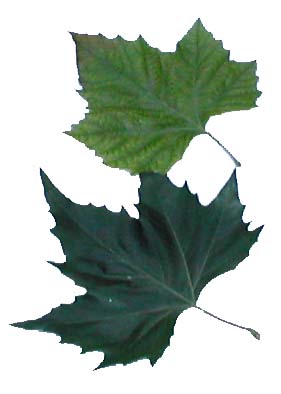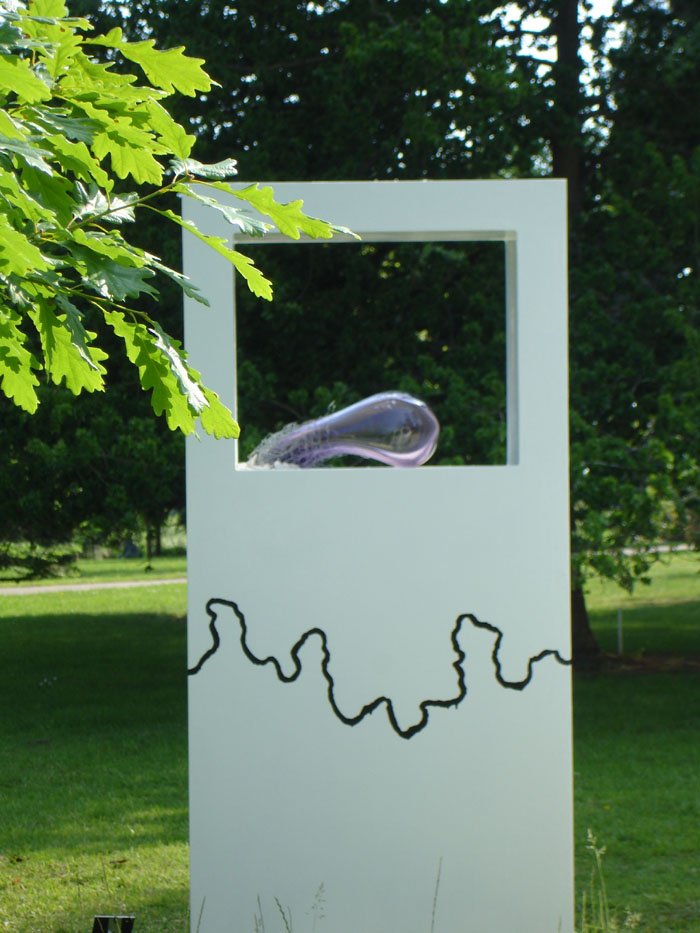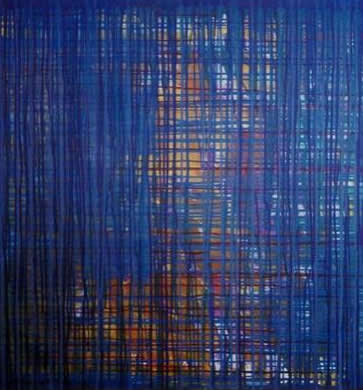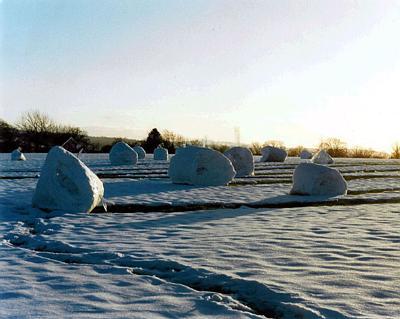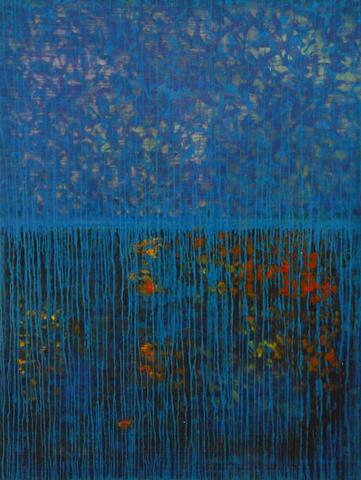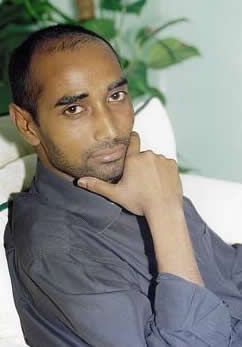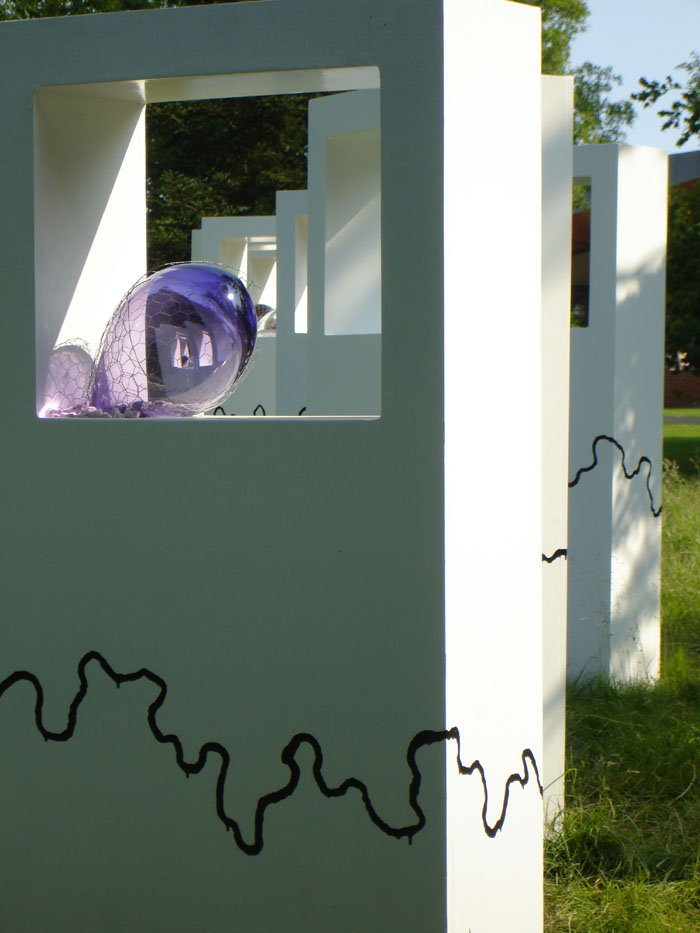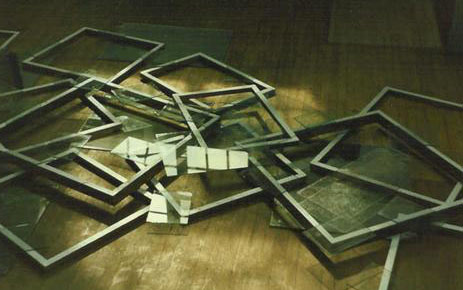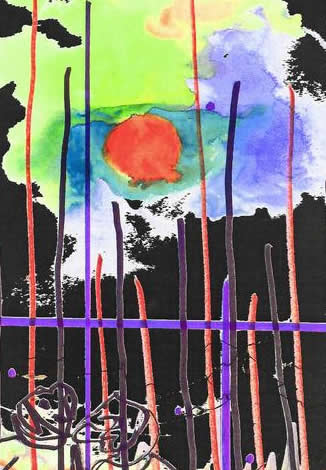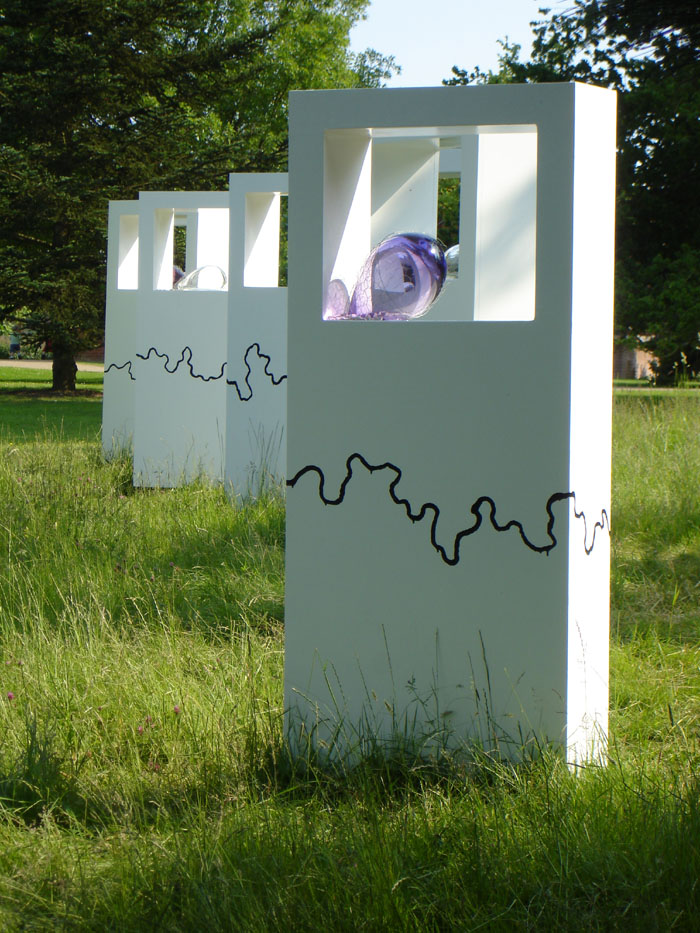At
an opening in Hackney Pascal. introduces me to Jafar and
we fall into an involved conversation about finding studio
space. Pascal has managed somehow to get himself a free
space in a soon to be demolished Council Block and I'm celebrating
the low rent on the small garage which I'm using as a studio.
Jafar is intending to move down from the North of England
and is looking for space so I go through the various lame
suggestions about where and how he might go about finding
one. He says that he's going to look at one the next day
and asks if I'll come along and see what I think. It turns
out that it is out in Woolwich by the London Airport somewhere
I've not been so intrigued, I agree to meet him the next
day.. as he's leaving he casually tells me that it is 6000
sq ft. in size. Modernity shifts its basis continuously;
it is a kind of perpetual change. When conditions don't
shift quickly enough the results can be a kind of war.
Logistics are the basis of modernity, moving things from
one place to the next. Speed, violence, transformation are
the qualities of a shattering machinery which undermines
its own ground. We can only stand and stare at the scale
of these operations. Where can a public art find its site
in a world where sites are swept away continuously? Meeting
at Tower Hill we head out east on the Docklands Light Railway.
Jafar is enthusiastic about the opportunities the ongoing
development of the old London docks offers artists. I'm
beginning to get a notion of the scale of his ambition.
It's a beautiful sunny day as the driverless toy like train
trips happily through the grinding jumbled environment whose
size always amazes me. Pascal was telling me this morning
about Jafar's vast studio in Lancashire. I'm impressed.
Somehow Abu's driving desire begins to animate my perception
of what I once saw as a kind of broken down difficult and
somewhat inhospitable desert. He seems to understand things
effortlessly on a level flush with a developing modernity.
This attitude seems able to invent a paradoxically refreshing
authenticity in the heat of self-conscious post-modernism.
Glass turns to ice in the unexpected glint of a modernist
dream.
Metal and glass are the materials whose combination defines
a particularly corporate architecture. In Brick Lane office
buildings are beginning to cut into the dark crumbling Georgian
surroundings. Right across the East End such gleaming blades
slice through the breaking down, broken down fabric of houses,
commercial building and crammed in Council blocks. The muddled
expanse of the area becomes the tabula rasa of planner's
drawing boards. Imagination falters and is wrenched apart
before this scattered and scattering vista. He tells me
of how, when he was at school he used to be paid by other
students to do detailed drawings for their science assignments.
This develops into a general conversation about drawing.
He says "drawing, drawing, drawing. I always drew.
Once I drew a Heron, like this". He quickly draws a
bird for me on a scrap of paper. "My father saw me
doing this flying Heron and told me 'Jafar you know you
are not allowed to do that'. It was breaking the Muslim
prohibition on figurative pictures. I come from a small
village, Jhilna in Patuakhali district of Bangladesh. Since
my father told me to stop drawing I would draw only at night.
I couldn't get art materials; it is a very rural environment....
Later my uncle (Abdur Rab) who encouraged me and my mother
did too... I just drew all the time when ever I could".
This story feels familiar to me in as much as my own drawing
was always a bit compulsive in class I doodled continuously,
illicitly filling my exercise books with elaborate designs.
Jafar smiles and tells me how he used to draw on the blackboard
when the teacher was out of the room.
" There was a Hindu house near my school with a statue
of the Goddess Durga... the one with ten hands. I was very
fascinated, one day skipping prayers time & I stay at
the class room to drew her on the blackboard. When I finished
the drawing I felt so happy and for got to erase the picture
from the blackboard, time was running out the class teacher
and my class mates came back to the class, I was sitting
on my place and class began for the session then every one
looking at the board and my teacher face went red, and asked
who drew this. I was afraid, so I kept quiet. Then he said
that it is really a good picture, if any one done from this
classroom he would give him a special prize. I put my hand
up then he call me to come forward near to the blackboard
and beat me up for the drawing. But it was not the end of
my drawing. Of course then I drew even more, I copied cinema
billboards on the blackboards, I had a captive audience
of pupils.. this was when I started to get paid to do their
science drawings.. I used to get good money!"
Abstraction is a way out of the interdiction on representational
figures of animals and humans in Muslim art. Pattern arabesque,
rhythm and formal design become a kind of information that
energises a nature of non-representational writing. Calligraphy
returns to Western Modernism as an iconoclastic force while
in other traditions it reflects an accepted language. Plugging
into the high ambition of American Abstract expressionism
means the work plays on a double culture authority. Through
the meeting of calligraphy and existentialism the questions
of signature and identity come back into play to be drowned
in a kind of liquid light. This is a kind of event, if by
that word we can mean a nature of poetic ending. Something
that happened is happening (and will happen) Jafar's painting
reflect a quest for identity and its loss, a quest that
encompasses the shards thrown up by a disastrous modernity.
Together with Jafar's proposals for vast reflective steel
sculptures the paintings articulate a drama with a confident
public flourish. From the link between drawing and writing
figures are quickly indicated before being slowly swamped
in a colourful flood.
Jafar
calls me and I go round to his home to help out with a press
release. He shows me drawings and plans of the event he
is planning in Brick Lane Banglatown. It is related to a
previous piece of work that took place in a field on the
outskirts of Brockhall Village, Lancashire. There Jafar
harvested snow, rolling into bales while drawing long lines
along the ground. Each snow roll was propped up with a sheet
of glass which at first, looking at the photograph, I took
to be ice. Hot and cold operate in the shock of one elegant
image. He offers me a poster depicting the piece. In the
plan for Brick Lane he is preparing actual bales of hay,
these will rest on glass sheets and will be wrapped in coils
of canvas strips which trailing back along the road are
covered in signatures harvested from pupils at a local school.
The use of signatures as a kind of decoration, as a affirmation
of identities which are then swept up into the ongoing logic
of an elaborate art project, calls attention to signing
as an activity.. a kind of flourishing. This is the nature
of Jafar's work.
At the recent Jackson Pollock exhibition I was similarly
struck how Pollock's signature became progressively embroiled
into becoming part of his paintings, to the point that the
paintings themselves become a kind of signature. Jafar's
project immerses itself in that kind of intensity. Just
as in the Italian 'Arte Povera' movement of the 1960's the
ground of painting joins with the floor itself to become
a field, Jafar's art becomes such a ground. I begin to see
how the move from a rural environment to an area of a city
going through massive change is for Jafar a movement from
one field to another. He spoke me once of the play of light
on the water near his home, the sun across the landscape,
now snow, glass and steel catch the light. " I like
this place" he says gesturing from the toy London Docklands
train. "It is change". We look out over the old
docks, over the river to the Millennium Dome and I begin
to realise that he understands in a startlingly sensuous
way the ground level on which all this is a based. This
understanding is his ambition, something that drives him
around the vast spaces of this apparently into hospitable
environment. His desire is able to act on this surface,
the roads themselves become intertwining gestures, a graffiti
whose traces become a sign of flourishing life. This perceptual
field is an infectiously affirmative experience. We smile
at each other. I thought that I was somehow beyond this
enthusiasm but now find myself standing on it. Vertigo.
The blurring of distinction between figure and ground is
a major factor in decorative art. In the classical arabesque
rhythm and pattern sweep both terms into an active mixture.
In Islamic traditions writing and decorative design become
similarly fused, design and sign become one form. Jafar's
work welds together signature and painterly decoration as
a ground, which then, (after a while) emerges as a figure
working energetically within the environment. This shared
emerging figure is endlessly at home because it continually
draws its own ground. Rather than basing a landscape on
a grid we find its foundation in the movement of a dynamic
arabesque.. in a flourish of signatures.
Jafar's practice replaces perspective with the swift appearance
and disappearance of fleeting figures, scribbles and signatures
drowned in his works reflection. Rather than the gridded
coherence of an American city such as New York (for example)
Jafar inhabits London as a site founded on consistency of
continual interruption. He looks for places to site his
open and active public art drawing on an experience of a
sinuous line. Mobile, broken and sometimes difficult to
grasp even as it catches the light, Jafar's plan reminds
of the Heron he sketched me on a piece of paper. I caught
sight of one these large birds yesterday down by the canal
near his studio and thought (oddly enough) of Jafar's projects
as it took flight. His proposed monuments, his painting
installations, the involved art event he is planning reflect
an unhurried interlacing, a body of work which I can neither
wholly figure out nor abandon as unfigurable. This open
questions is a pleasurable one, it has its own growing momentum
as it takes off and accelerates across discontinuous fields,
a swift, yet unhurried flight from pre-industrial environment
to a post-industrial one.
When the distinction between city and rural life is washed
away in a tangled rhythm of roads there is an opportunity
to investigate new sites for art. Jafar's project becomes
for me a kind of writing between projects. It is able to
draw itself as a multi-dimensional support, the continual
liquid basis for fundamentally heterogeneous realities.
It works as a number of proposals. It is the project of
a starting manifestation of a immanent growth of artistic
desire beyond itself. This drawing is one which indicates
and affirms a flood of sensational appearances. Abstraction
ambition therefore becomes (momentarily and monumentally)
animate.
